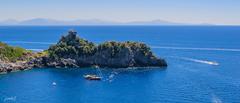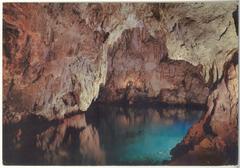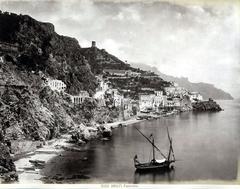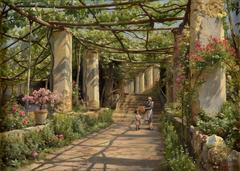Amalfi Cathedral: Visiting Hours, Tickets & Comprehensive Travel Guide
Date: 15/06/2025
Introduction
Amalfi Cathedral (Cattedrale di Sant’Andrea), set in the heart of the Amalfi Coast, is a spectacular testament to centuries of faith, artistry, and cultural exchange. Dedicated to Saint Andrew, whose relics reside in its crypt, the cathedral is celebrated for its remarkable blend of architectural styles—Romanesque, Byzantine, Arab-Norman, Gothic, Renaissance, and Baroque—symbolizing Amalfi’s historic role as a Mediterranean crossroads. This guide details everything you need to know for an enriching visit, from historical context and architectural highlights to up-to-date visiting hours, ticketing, accessibility, and travel tips. Whether you are a history buff, a pilgrim, or a leisure traveler, this article will help you experience one of Italy’s most iconic monuments to its fullest (visitamalfi.info; Wikipedia; catholicshrinebasilica.com).
Table of Contents
- Introduction
- History & Architectural Overview
- Relics and Spiritual Significance
- Visiting Amalfi Cathedral
- Practical Travel Tips
- Nearby Attractions
- Frequently Asked Questions (FAQ)
- Conclusion and Further Reading
History & Architectural Overview
Origins and Early Development
The cathedral’s history begins in the 9th century, with the construction of the Basilica of the Crucifix—now home to the Museum of Sacred Art (visitamalfi.info). As Amalfi flourished as a maritime republic, the cathedral expanded to reflect its growing prestige and wealth.
Major Architectural Phases
- Romanesque Core: The original basilica, characterized by semicircular arches and heavy masonry, forms the foundation of the present cathedral (Wikipedia).
- Arab-Norman and Byzantine Influences: The cathedral absorbed decorative and structural motifs from Byzantine and Islamic traditions, a testament to Amalfi’s vibrant trade connections (Wikipedia).
- Gothic, Renaissance, and Baroque Additions: Periodic renovations introduced pointed arches, frescoes, and gilded Baroque interiors. The nave’s stucco work and ceiling paintings by Andrea dell’Asta are notable highlights.
Cloister of Paradise
Constructed between 1266 and 1268, this tranquil cloister was intended as a burial ground for Amalfi’s nobility. Its slender columns and pointed arches evoke Moorish courtyards, while its galleries house medieval sarcophagi and frescoes (visitamalfi.info).
Bell Tower and Façade
- Bell Tower: Built from the 12th to 13th centuries, the bell tower features a unique blend of Romanesque structure and Moorish decorative tiles (Wikipedia).
- 19th-Century Façade: After a collapse in 1861, the façade was rebuilt, using ornate marble, mosaics, and a grand staircase leading up from Piazza Duomo. The bronze doors, cast in Constantinople in the 11th century, are among the earliest of their kind in Italy.
Relics and Spiritual Significance
The Crypt of St. Andrew
The crypt, completed in 1208, houses the relics of Saint Andrew the Apostle, brought from Constantinople after the Fourth Crusade. This sacred space features a bronze statue of St. Andrew by Michelangelo Naccherino and marble sculptures by Pietro Bernini (Wikipedia). Pilgrims are drawn to the crypt both for its artistic beauty and for its aura of sanctity.
The Gift of Manna
A unique phenomenon known as the “Manna of Saint Andrew”—a liquid said to exude from the saint’s bones—is venerated annually, especially during the festivals on November 30 and June 27. These celebrations are an integral part of Amalfi’s religious and social calendar (visitamalfi.info; catholicshrinebasilica.com).
Visiting Amalfi Cathedral
Hours and Tickets
- Visiting Hours:
- March–June: 9:00 AM–6:45 PM daily
- July–September: Extended to 7:45 PM
- November–February: 10:00 AM–1:00 PM and 2:30 PM–4:30 PM
- Sundays and holidays may have shorter hours; check official resources before your visit (costieraamalfitana.com).
- Tickets:
- Cathedral entry: Free during Mass times
- Museum of Sacred Art, Cloister of Paradise, and Crypt: €3–€7 (combined ticket)
- Children under 18: Free
- Tickets available on-site; no advance booking required
Accessibility
The cathedral is reached via 62 steep steps from Piazza Duomo, making wheelchair access challenging. The Diocesan Museum is more accessible, but those with mobility concerns should inquire in advance about possible assistance (Wikipedia).
Dress Code and Visitor Conduct
Dress modestly: shoulders and knees must be covered. Lightweight scarves or shawls are recommended, especially in summer. Silence is appreciated inside, particularly during services and in the crypt.
Guided Tours and Audio Guides
Guided tours and audio guides are available in several languages, offering in-depth historical and artistic insights. Booking can be done on-site or through local agencies.
Getting There
- By Road: SITA buses run along the Amalfi Coast (SS163). Parking is limited and expensive.
- By Sea: Ferries connect Amalfi with Positano, Salerno, and Capri.
- By Train: The nearest station is Vietri sul Mare, with onward bus or taxi links.
- The cathedral is centrally located—just steps from the ferry port and bus station.
Facilities and Amenities
There are no restrooms inside the complex; public toilets are available in Piazza Duomo. Water fountains and numerous cafés surround the cathedral.
Practical Travel Tips
Best Times to Visit
- Early mornings or late afternoons on weekdays are ideal for avoiding crowds.
- Avoid major religious festivals if you seek a quieter experience.
Duration and Experience
- Allow 1.5–2 hours for a full visit, including the church, cloister, crypt, and museum.
Photography
- Photography without flash or tripods is permitted, except during Mass or in areas where signs prohibit it.
Family, Couples, and Group Visits
- The cathedral offers a memorable experience for all, with dramatic architecture, peaceful cloisters, and engaging museum exhibits.
Nearby Attractions
- Piazza Duomo: The vibrant heart of Amalfi, with shops and cafés.
- Museo della Carta: Discover Amalfi’s paper-making tradition.
- Ancient Arsenal: Explore the maritime history of the republic.
- Scenic Walks and Boat Trips: Easy access to Ravello, Positano, and Capri.
Frequently Asked Questions (FAQ)
Q: What are Amalfi Cathedral’s visiting hours?
A: Hours vary seasonally; generally open daily from 9:00 AM to 6:45 PM (summer) and shorter hours in winter. Check official sources before your visit.
Q: Is there an entry fee?
A: Entry to the main cathedral is free during Mass. Tickets (€3–€7) are required for the crypt, museum, and cloister.
Q: Are guided tours available?
A: Yes, in multiple languages. Book on-site or online.
Q: Is the cathedral accessible for those with mobility issues?
A: The main staircase is steep and not wheelchair accessible. Contact the cathedral for possible assistance.
Q: Can I take photos?
A: Yes, but without flash or tripods, and with respect for the sacred environment.
Conclusion
Amalfi Cathedral is a unique blend of faith, art, and history, reflecting the rich tapestry of influences that have shaped the Amalfi Coast. With its sacred relics, striking architecture, and vibrant community life, the cathedral offers a profound experience for every visitor. Plan your visit with updated practical information, enjoy a guided tour for deeper insights, and explore the treasures of Amalfi’s historic center.
For more details, consult the official cathedral website, the Amalfi Coast tourism portal, or download the Audiala app for guided tours and travel tips.
View Amalfi Cathedral on the Map
References and Further Reading
- Amalfi Cathedral Visiting Hours, Tickets, and Historical Guide to Amalfi’s Iconic Monument, VisitAmalfi.info
- Amalfi Cathedral Visiting Hours, Tickets, and Complete Visitor Guide to Amalfi’s Historic Landmark, Wikipedia
- Amalfi Cathedral Visiting Hours, Tickets, and Historical Guide to Amalfi’s Iconic Monument, CatholicShrineBasilica.com
- Amalfi Cathedral Visiting Hours, Tickets, and Practical Guide to Amalfi Historical Sites, Pilgrim-Info.com
- The Artistic and Religious Mysticism of the Amalfi Cathedral, AuthenticAmalfiCoast.it
Note: Please verify visiting hours and ticket prices before your trip as they may change seasonally or due to special events.




